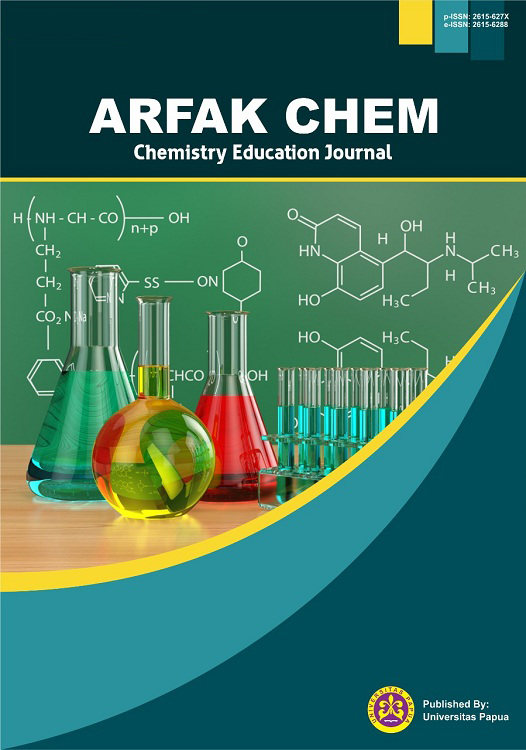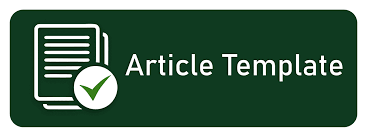PENERAPAN MODEL NUMBEREAD HEADS TOGETHER (NHT) UNTUK MENINGKATKAN HASIL BELAJAR PESERTA DIDIK PADA MATERI LARUTAN PENYANGGA DI KELAS XI IPA 1 SMA YPK OIKOUMENE MANOKWARI
DOI:
https://doi.org/10.30862/accej.v1i2.48Keywords:
model pembelajaran numberead heads together (nht), hasil belajar, larutan penyangga, penelitian tindakan kelas, sma ypk oikoumene manokwari.Abstract
Penelitian tindakan kelas ini bertujuan untuk meningkatkan hasil belajar peserta didik SMA YPK Oikoumene Manokwari pada materi lautan penyangga melalui model pembelajaran Numberead Heads Together (NHT). Model pembelajaran Numberead Heads Together digunakan sebagai alternatif untuk memecahkan masalah. Penelitian tindakan kelas ini dilakukan dalam dua siklus setiap siklus meliputi 4 tahap: (1). Perencanaan, (2) pelaksanaan, (4) obervasi, Refleksi, dengan subjek penelitian yaitu kelas XI IPA 1 dengan jumlah peserta didik 18 orang. Teknik Pengumpulan data yang digunakan pada penelitian ini yaitu Observasi dan Tes. Sedangkan validitas data yang digunakan yaitu validitas instrument. Hasil penelitian ini menunjukkan bahwa penerapan model pembelajaran Numberead Heads Together (NHT) dapat meningkatkan hasil belajar peserta didik kelas XI IPA 1 SMA YPK Oikoumene Manokwari. Untuk Hasil Belajar diperoleh Rata-rata 67.09 dengan ketuntasan 56% pada Siklus I kemudian meningkat nilai rata-rata sebesar 82,05 dengan ketuntasan 83% pada siklus II. Hal ini menunjukan bahwa terjadi peningkatan ketuntasan hasil belajar sebesar 27%.
References
Arikunto, S. Penelitian Tindakan Kelas Edisi Revisi . Jakarta: Bumi Aksara. 2007
Mulyasa, E. Kurikulum Tingkat Satuan Pendidikan. Bandung: PT. Remaja Rosdakarya. 2007
Nursiyem. Meningkatkan Hasil Belajar IPA Pada Materi Bagian Tumbuhan dan Fungsinya Melalui Penerapan Metode Kerja Kelompok pada Siswa kelas IV SD Inpres Tandaigi. Palu: Untad. 2012
Nur, M. Strategi-strategi Belajar. Edisi 1. Surabaya: Pusat Studi Matematika dan IPA Unesa. University Pres. 2000
Purba, M & Sunaardi. kimia untuk SMA/MA kelas X.jakarta: Erlangga. 2006.
Purba, M & Sunardi. kimia untuk SMA/MA kelas XI. Jakarta: Erlangga. 2006.
Suparman, A.R. Penggunaan Model Kooperatif Tipe Group Investigation (GI) untuk Meningkatkan Aktivitas dan Hasil Belajar Mahasiswa Pada Materi Struktur dan Sifat-sifat Atom. “Jurnal Inovasi Pendidikan Sains. 9(1).2018: 17-22.
Downloads
Published
How to Cite
Issue
Section
License
License and Copyright Agreement
In submitting the manuscript to the journal, the authors certify that:
- They are authorized by their co-authors to enter into these arrangements.
- The work described has not been formally published before, except in the form of an abstract or as part of a published lecture, review, thesis, or overlay journal. Please also carefully read Arfak Chem: Chemistry Education Journal Posting Your Article Policy at http://journalfkipunipa.org/index.php/accej/about
- That it is not under consideration for publication elsewhere,
- That its publication has been approved by all the author(s) and by the responsible authorities – tacitly or explicitly – of the institutes where the work has been carried out.
- They secure the right to reproduce any material that has already been published or copyrighted elsewhere.
- They agree to the following license and copyright agreement.
Copyright
Authors who publish with Arfak Chem: Chemistry Education Journal agree to the following terms:
- Authors retain copyright and grant the journal right of first publication with the work simultaneously licensed under a Creative Commons Attribution License (CC BY-ND 4.0) that allows others to share the work with an acknowledgment of the work's authorship and initial publication in this journal.
- Authors are able to enter into separate, additional contractual arrangements for the non-exclusive distribution of the journal's published version of the work (e.g., post it to an institutional repository or publish it in a book), with an acknowledgment of its initial publication in this journal.
- Authors are permitted and encouraged to post their work online (e.g., in institutional repositories or on their website) prior to and during the submission process, as it can lead to productive exchanges, as well as earlier and greater citation of published work.









